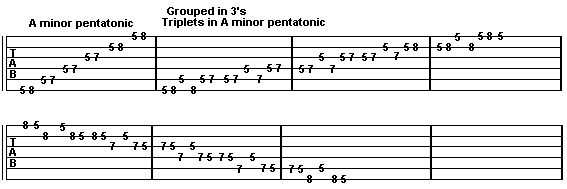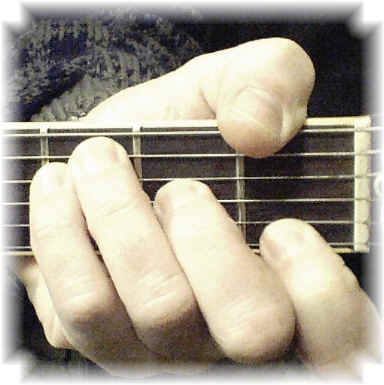Timing Exercises
In this lesson I would like to introduce some timing exercises. We will also play an exercise covering 5 different positions of the Am pentatonic scale. We will play over a rhythm using the Am F and G chords. Sound files have been included.
I've played an exercise using 5 different positions of the Am pentatonic scale. This exercise uses the Am pentatonic scale root note position, this is played at the 5th fret. The next position starts at the C note 8th fret. The next position starts at the D note, 10 fret. Then the E note, 12th fret and then the G note 15th fret. I have used an acoustic guitar for this exercise, but an electric guitar will work fine and should be a bit easier playing the exercises.
Look at the illustration below. This is the rhythm we will now use to play the Am pentatonic scale over in our next lesson. I will be introducing a few different positions to play this Am pentatonic scale. I didn't plan for the lead we will be learning to have any melodic value, but more of an exercise to get you moving around the fret board. The Rhythm below plays through twice. You start by playing the Am chord. You play the Am chord for 8 beats and then the F and G chords for 4 beats each. You will need to learn this rhythm now and if possible, record it to a cassette or CD. Play it for as long as possible, like it was a complete song. Listen to it and begin to train your ear for each note and chord being played. I've only played it through twice here. So play it over and over until you can play it smooth and with out looking.
| Rhythm | |
| Drum Track | |
| Counting over the rhythm above |
|
Use the Drum track to play these chords over. You would count as follows for each chord played.
| Am chord 1 and 2 and 3 and 4 and 1 and 2 and 3 and 4 and | |
| F chord 1 and 2 and 3 and 4 and | |
| G chord 1 and 2 and 3 and 4 and repeat to the Am chord once more. |
I usually get the heal of my foot rocking to the beat.
(Heal of the foot down = 1) (heal of the foot up = And)
It would really be a good idea to get a metronome to keep your timing. A metronome is a device you use to learn timing. They come in various styles, from wind up to electric styles. You can find them in most music stores. The metronome allows you to set the speed to which you feel comfortable with. I will always try to demonstrate the lessons at the lower speed or beat.
Below you will find music symbols and basic timing signatures. You will also find some scale exercises using different types of techniques, such as triplets, quadruplets etc.






In our next lesson we will play 5 different positions of the Am pentatonic scale over the rhythm above. It is a good idea now to review all of the positions of the Am pentatonic scale.
Assignments:
| Practice the rhythm above as much as possible. | |
| Count as you play, 1 and 2 and 3 and 4. | |
| Listen to the track with counting over the rhythm above. | |
| Listen to the track playing the exercises in 5 different positions. | |
| In the next lesson we will work on the 5 different positions. | |
| Play the root 6 bar chords in every position along the Low E string. | |
| Play the root 5 bar chords in every position along the A string. | |
| Look over all the minor progressions. | |
| Play some of the major progressions. |
Good Luck,
From the Jam Room








